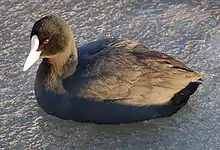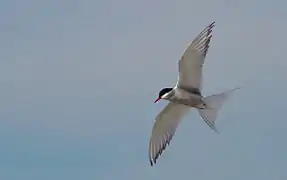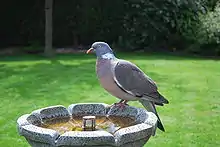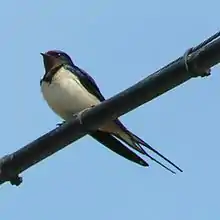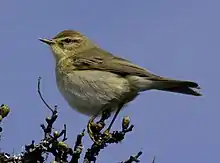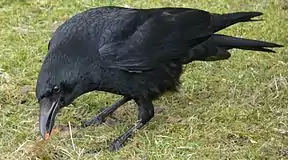List of birds of Leicestershire and Rutland
Leicestershire and Rutland are neighbouring counties in the English Midlands. Rutland is the smallest county in England and its administration was amalgamated with its larger neighbour between 1974 and 1997. Since 1941, the two counties have shared a single bird-recording organisation, the Leicestershire and Rutland Ornithological Society (LROS).[1]
.jpg.webp)
Since 1 January 1941, the date of the foundation of the LROS, 290 bird species have been recorded in the counties in an apparently natural wild state at least once. A further nine were documented prior to that date, but have not been recorded subsequently. There are nine introduced species that maintain themselves without necessary recourse to further introduction. The total list for the LROS recording area is therefore 308 species.[2]
Leicestershire and Rutland are landlocked lowland counties and most of the birds are typical of English farmland habitat. Many coastal, oceanic and highland birds are absent or rare, and there are few rare vagrants compared to coastal areas. The construction of two large reservoirs, Eyebrook Reservoir in 1940 and Rutland Water (England's largest reservoir) in 1976, has provided freshwater environments enabling many aquatic birds to thrive.[3]
The list below is based on the LROS checklist, using BOU species names,[4] and the status descriptors in the accounts have the following meanings:[2]
- Very rare: fewer than ten records ever
- Rare: more than ten records ever, but less than annual
- Scarce: fewer than ten birds occurring or pairs breeding annually
- Uncommon: 10–100 birds occurring or pairs breeding annually
- Fairly common: 100–1,000 birds occurring or pairs breeding annually
- Common: 1,000–10,000 birds occurring or pairs breeding annually
- Abundant: more than 10,000 birds occurring or pairs breeding annually
In the list below, "BBRC" means that a full description of nationally rare species is required for acceptance of the record by the British Birds Rarities Committee, and "LROS" indicates that a description of county rarities is required for acceptance of the record by the LROS Records Committee. Photographs of birds illustrating the list are not all taken within the locality.
Ducks, geese and swans
Order: Anseriformes Family: Anatidae
The swans, ducks and geese are medium to large birds that are adapted to an aquatic existence with webbed feet and bills which are flattened to a greater or lesser extent. In many ducks the male is colourful while the female is dull brown. The diet consists of a variety of animals and plants. The family is well represented in the counties, especially in winter when large numbers visit from further north.
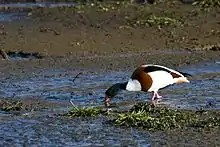
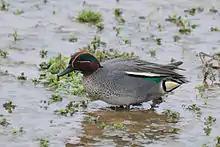
| Common name | Binomial | Status |
|---|---|---|
| Mute swan | Cygnus olor | Fairly common resident; uncommon to fairly common breeding |
| Bewick's swan | Cygnus columbianus | Uncommon in winter and on passage |
| Whooper swan | Cygnus cygnus | Scarce in winter and on passage |
| Bean goose | Anser fabalis | Rare in winter, LROS |
| Pink-footed goose | Anser brachyrhynchus | Scarce in winter and uncommon on passage |
| White-fronted goose | Anser albifrons | Scarce to uncommon in winter, mainly escapes |
| Greylag goose | Anser anser | Fairly common feral resident; uncommon breeding |
| Canada goose | Branta canadensis | Introduced common resident; fairly common breeding |
| Barnacle goose | Branta leucopsis | Rare in winter, uncommon feral resident |
| Brent goose | Branta bernicla | Scarce in winter and uncommon on passage |
| Egyptian goose | Alopochen aegyptiaca | Introduced. Uncommon resident, scarce breeding |
| Ruddy shelduck | Tadorna ferruginea | Rare vagrant or escapee |
| Common shelduck | Tadorna tadorna | Uncommon in winter and on passage, scarce breeding |
| Mandarin duck | Aix galericulata | Introduced. Uncommon resident, scarce breeding |
| Eurasian wigeon | Anas penelope | Common in winter and on passage, scarce in summer |
| American wigeon | Anas americana | Very rare, LROS |
| Gadwall | Anas strepera | Common in winter and on passage, uncommon breeding |
| Eurasian teal | Anas crecca | Common in winter and on passage, uncommon breeding |
| Green-winged teal | Anas carolinensis | Very rare, LROS |
| Mallard | Anas platyrhynchos | Common in winter and on passage, fairly common breeding |
| Northern pintail | Anas acuta | Uncommon to fairly common in winter and on passage |
| Garganey | Anas querquedula | Scarce to uncommon on passage; very rare breeding |
| Blue-winged teal | Anas discors | Very rare, BBRC |
| Northern shoveler | Anas clypeata | Fairly common in winter; rare-scarce breeding |
| Red-crested pochard | Netta rufina | Scarce in winter and on passage |
| Common pochard | Aythya ferina | Fairly common to common, rare breeding |
| Redhead | Aythya americana | Very rare, BBRC |
| Ring-necked duck | Aythya collaris | Very rare, LROS |
| Ferruginous duck | Aythya nyroca | Rare in winter and on passage, LROS |
| Tufted duck | Aythya fuligula | Common in winter and on passage, uncommon breeding |
| Greater scaup | Aythya marila | Uncommon in winter and on passage |
| Lesser scaup | Aythya affinis | Very rare, BBRC |
| Common eider | Somateria mollissima | Rare in winter and on passage, LROS |
| Long-tailed duck | Clangula hyemalis | Rare in winter |
| Common scoter | Melanitta nigra | Rare in winter and uncommon on passage |
| Velvet scoter | Melanitta fusca | Rare in winter and on passage, LROS |
| Surf scoter | Melanitta perspicillata | Very rare vagrant- one record 2016-2017 LROS |
| Common goldeneye | Bucephala clangula | Fairly common in winter and on passage, uncommon in summer |
| Smew | Mergellus albellus | Uncommon in winter |
| Red-breasted merganser | Mergus serrator | Scarce in winter and on passage |
| Goosander | Mergus merganser | Fairly common in winter and on passage |
| Ruddy duck | Oxyura jamaicensis | Introduced. Uncommon in winter, scarce breeding |
Grouse
Order: Galliformes Family: Tetraonidae
Grouse are sturdy, medium-sized terrestrial birds of the Northern Hemisphere. They have feathered feet and nostrils and short, rounded wings. They feed mainly on plant material and lay their eggs in a simple scrape on the ground. They are gamebirds and large numbers were shot in the past in moorland areas.
| Common name | Binomial | Status |
|---|---|---|
| Red grouse | Lagopus lagopus | Extinct resident since about 1840[5] |
| Eurasian black grouse | Tetrao tetrix | Extinct resident since about 1840[5] |
Pheasants, partridges and quail
Order: Galliformes Family: Phasianidae
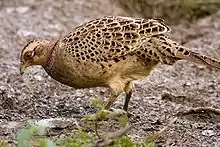
Pheasants and allies are terrestrial species, feeding and nesting on the ground. They are variable in size but generally plump, with broad and relatively short wings.
| Common name | Binomial | Status |
|---|---|---|
| Red-legged partridge | Alectoris rufa | Common introduced resident breeder |
| Grey partridge | Perdix perdix | Uncommon resident breeder |
| Common quail | Coturnix coturnix | Scarce summer visitor, breeds |
| Common pheasant | Phasianus colchicus | Common introduced resident breeder |
Divers
Order: Gaviiformes Family: Gaviidae
Divers are aquatic birds the size of a large duck, to which they are unrelated. They swim well and fly adequately but, because their legs are placed towards the rear of the body, are clumsy on land. They feed on fish and other aquatic animals.
| Common name | Binomial | Status |
|---|---|---|
| Red-throated diver | Gavia stellata | Rare in winter, LROS |
| Black-throated diver | Gavia arctica | Rare in winter, LROS |
| Great northern diver | Gavia immer | Scarce in winter |
Grebes
Order: Podicipediformes Family: Podicipedidae
Grebes are small to medium-large diving birds with lobed toes and pointed bills. They are seen mainly on lowland waterbodies and coasts. They feed on aquatic animals and nest on a floating platform of vegetation. There are about 19 species worldwide with five in Leicestershire and Rutland.
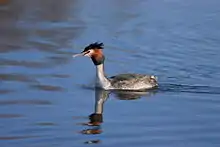
| Common name | Binomial | Status |
|---|---|---|
| Little grebe | Tachybaptus ruficollis | Uncommon to fairly common breeding |
| Great crested grebe | Podiceps cristatus | Fairly common in winter and on passage, uncommon breeding |
| Red-necked grebe | Podiceps grisegena | Scarce in winter and on passage |
| Slavonian grebe | Podiceps auritus | Scarce in winter and on passage |
| Black-necked grebe | Podiceps nigricollis | Uncommon in summer and on passage, rare in winter |
| Pied-billed grebe | Podilymbus podiceps | Very rare |
Shearwaters and petrels
Order: Procellariiformes Family: Procellariidae
These are highly pelagic birds with long, narrow wings and tube-shaped nostrils. They feed at sea on fish, squid and other marine life. They come to land to breed in colonies, nesting in burrows or on cliffs. There are about 77 species worldwide, two of which are rare vagrants to Leicestershire and Rutland.
| Common name | Binomial | Status |
|---|---|---|
| Northern fulmar | Fulmarus glacialis | Very rare, LROS |
| Manx shearwater | Puffinus puffinus | Very rare, LROS |
Storm petrels
Order: Procellariiformes Family: Hydrobatidae
The storm-petrels are the smallest seabirds, feeding on plankton and small fish picked from the surface, typically while hovering. They nest in colonies on the ground, most often in burrows. There are about 20 species worldwide, two of which are rare vagrants to Leicestershire and Rutland.
| Common name | Binomial | Status |
|---|---|---|
| European storm petrel | Hydrobates pelagicus | Very rare, LROS |
| Leach's storm petrel | Oceanodroma leucorhea | Very rare, LROS |
Gannets
Order: Suliformes Family: Sulidae
Gannets are large seabirds that plunge-dive for fish and nest in large colonies. They have a torpedo-shaped body, long, narrow, pointed wings and a fairly long tail. There are about 10 species worldwide, with one recorded as a rare vagrant to Leicestershire and Rutland.
| Common name | Binomial | Status |
|---|---|---|
| Northern gannet | Morus bassanus | Very rare, LROS |
Cormorants
Order: Suliformes Family: Phalacrocoracidae
Cormorants are medium to large aquatic birds with mainly dark plumage and areas of coloured skin on the face. The bill is long, thin and sharply hooked for catching fish and aquatic invertebrates. They nest in colonies, usually by the sea. There are about 39 species worldwide, with two recorded in Leicestershire and Rutland.
| Common name | Binomial | Status |
|---|---|---|
| Great cormorant | Phalacrocorax carbo | Fairly common all year, common breeding |
| Common shag | Phalacrocorax aristotelis | Scarce in winter and on passage |
Bitterns, herons and egrets
Order: Pelecaniformes Family: Ardeidae
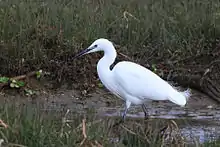
Herons and egrets are medium to large wading birds with long necks and legs. Bitterns tend to be shorter-necked and more secretive. They all fly with their necks retracted. The sharp bill is used to catch fish, amphibians and other animals. Many species nest in colonies, often in trees.
| Common name | Binomial | Status |
|---|---|---|
| Great bittern | Botaurus stellata | Scarce in winter |
| Little bittern | Ixobrychus minutus | Very rare, BBRC |
| Black-crowned night heron | Nycticorax nycticorax | Very rare, LROS |
| Squacco heron | Ardeola ralloides | Very rare, BBRC |
| Cattle egret | Bubulcus ibis | Very rare, BBRC |
| Little egret | Egretta garzetta | Uncommon in summer and on passage |
| Great egret | Ardea alba | Very rare, LROS |
| Grey heron | Ardea cinerea | Fairly common, breeds |
| Purple heron | Ardea purpurea | Very rare, LROS |
Ibises and spoonbills
Order: Pelecaniformes Family: Threskiornithidae
A family of long-legged, long-necked wading birds. Ibises have long, curved bills. Spoonbills have a flattened bill, wider at the tip.
| Common name | Binomial | Status |
|---|---|---|
| Common spoonbill | Platalea leucorodia | Rare |
Storks
Order: Ciconiiformes Family: Ciconiidae
Storks are large, heavy, long-legged, long-necked wading birds with long stout bills and wide wingspans. They fly with the neck extended.
| Common name | Binomial | Status |
|---|---|---|
| Black stork | Ciconia nigra | Very rare, BBRC |
| White stork | Ciconia ciconia | Very rare, LROS |
Osprey
Order: Accipitriformes Family: Pandionidae
A large migratory fish-eating bird of prey in a family of its own. It is mainly brown above and white below with long, angled wings.
| Common name | Binomial | Status |
|---|---|---|
| Osprey | Pandion haliaetus | Scarce on passage, scarce introduced breeder[6] |
Buzzards, kites and allies
Order: Accipitriformes Family: Accipitridae
A family of birds of prey which includes hawks, buzzards, eagles, kites and harriers. These birds have very large powerful hooked beaks for tearing flesh from their prey, strong legs, powerful talons and keen eyesight.
| Common name | Binomial | Status |
|---|---|---|
| European honey buzzard | Pernis apivorus | Rare, LROS |
| Red kite | Milvus milvus | Rare on passage, very rare breeder (spread from re-introduction in Northamptonshire)[7] |
| White-tailed eagle | Haliaeetus albicilla | Very rare, LROS |
| Marsh harrier | Circus aeruginosus | Uncommon on passage |
| Hen harrier | Circus cyaneus | Scarce, LROS |
| Pallid harrier | Circus macrourus | Very rare, BBRC |
| Montagu's harrier | Circus pygargus | Very rare, LROS |
| Northern goshawk | Accipiter gentilis | Rare to scarce, LROS |
| Eurasian sparrowhawk | Accipiter nisus | Fairly common resident |
| Common buzzard | Buteo buteo | Uncommon to fairly common resident and on passage |
| Rough-legged buzzard | Buteo lagopus | Rare in winter and on passage, LROS |
| Golden eagle | Aquila chrysaetos | Very rare, one record 1895 LROS[8] |
Falcons
Order: Falconiformes Family: Falconidae
A family of small to medium-sized, diurnal birds of prey with pointed wings. They do not build their own nests and mainly catch prey in the air.
| Common name | Binomial | Status |
|---|---|---|
| Common kestrel | Falco tinnunculus | Fairly common breeding resident |
| Red-footed falcon | Falco vespertinus | Very rare, LROS |
| Merlin | Falco columbarius | Scarce in winter and on passage, LROS |
| Eurasian hobby | Falco subbuteo | Scarce to uncommon breeding summer visitor |
| Peregrine falcon | Falco peregrinus | Uncommon in winter and on passage, scarce breeding |
Rails, crakes and coots
Order: Gruiformes Family: Rallidae
Rails and allies mainly occupy dense vegetation in damp environments near lakes, marshes or rivers. Many are shy and secretive birds, making them difficult to observe. Most species have strong legs and long toes which are well adapted to soft uneven surfaces.
| Common name | Binomial | Status |
|---|---|---|
| Water rail | Rallus aquaticus | Uncommon in winter and on passage, rare breeding |
| Spotted crake | Porzana porzana | Rare on passage, bred in nineteenth century, LROS[5] |
| Little crake | Porzana parva | Very rare, one old record from 1841, BBRC[9] |
| Baillon's crake | Porzana pusilla | Very rare, BBRC |
| Corn crake | Crex crex | Very rare, bred to about 1960, LROS[5] |
| Common moorhen | Gallinula chloropus | Common resident breeder |
| Eurasian coot | Fulica atra | Common in winter, fairly common breeding |
Cranes
Order: Gruiformes Family: Gruidae
Cranes are large, long-legged and long-necked birds. Unlike the similar-looking but unrelated herons, cranes fly with necks outstretched, not pulled back. Most have elaborate and noisy courting displays or "dances".
| Common name | Binomial | Status |
|---|---|---|
| Common crane | Grus grus | Very rare, LROS |
Oystercatchers
Order: Charadriiformes Family: Haematopodidae
The oystercatchers are large, obvious and noisy wading birds with strong bills used for smashing or prising open molluscs. There are about 11 species worldwide with one recorded in Leicestershire and Rutland.
| Common name | Binomial | Status |
|---|---|---|
| Pied oystercatcher | Haematopus ostralegus | Uncommon on passage, scarce breeding |
Avocets and stilts
Order: Charadriiformes Family: Recurvirostridae
A family of fairly large wading birds. The avocets have long legs and long up-curved bills. The stilts have extremely long legs and long, thin, straight bills. There are about 10 species worldwide, with two recorded in Leicestershire and Rutland.
| Common name | Binomial | Status |
|---|---|---|
| Black-winged stilt | Himantopus himantopus | Very rare, LROS |
| Pied avocet | Recurvirostra avosetta | Rare to scarce on passage, rare breeding |
Thick-knees
Order: Charadriiformes Family: Burhinidae
A small family of medium to large waders with strong black bills, large yellow eyes and cryptic plumage. There are 9 species worldwide, with one recorded in Leicestershire and Rutland.
| Common name | Binomial | Status |
|---|---|---|
| Stone-curlew | Burhinus oedicnemus | Very rare, bred to about 1880, LROS[5] |
Pratincoles and coursers
Order: Charadriiformes Family: Glareolidae
A family of slender, long-winged wading birds. There are 17 species worldwide, three of which have occurred as vagrants in Leicestershire and Rutland.
| Common name | Binomial | Status |
|---|---|---|
| Cream-coloured courser | Cursorius cursor | Very rare, one 1827 record, BBRC[10] |
| Collared pratincole | Glareola pratincola | Very rare, BBRC |
| Black-winged pratincole | Glareola nordmanni | Very rare, BBRC |
Plovers and lapwings
Order: Charadriiformes Family: Charadriidae
Small to medium-sized wading birds with compact bodies, short, thick necks and long, usually pointed, wings. There are about 66 species worldwide, nine of which have been recorded in Leicestershire and Rutland.
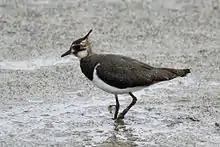
| Common name | Binomial | Status |
|---|---|---|
| Little ringed plover | Charadrius dubius | Uncommon on passage and breeding |
| Ringed plover | Charadrius hiaticula | Fairly common on passage, scarce breeding |
| Killdeer | Charadrius vociferus | Very rare, BBRC |
| Kentish plover | Charadrius alexandrinus | Very rare, LROS |
| Eurasian dotterel | Charadrius morinellus | Rare on passage, LROS |
| American golden plover | Pluvialis dominica | Very rare, LROS |
| European golden plover | Pluvialis apricaria | Common in winter and on passage |
| Grey plover | Pluvialis squatarola | Scarce in winter and on passage |
| Northern lapwing | Vanellus vanellus | Abundant in winter; fairly common breeding |
Sandpipers and allies
Order: Charadriiformes Family: Scolopacidae
A large, diverse family of wading birds. Different lengths of legs and bills enable multiple species to feed in the same habitat, particularly on the coast, without direct competition for food. There are about 89 species worldwide, 32 of which have been recorded in Leicestershire and Rutland.

| Common name | Binomial | Status |
|---|---|---|
| Red knot | Calidris canutus | Scarce on passage, rare in winter |
| Sanderling | Calidris alba | Scarce to uncommon on passage |
| Little stint | Calidris minuta | Uncommon on passage, rare in winter |
| Temminck's stint | Calidris temminckii | Rare, LROS |
| White-rumped sandpiper | Calidris fuscicollis | Very rare, LROS |
| Baird's sandpiper | Calidris bairdii | Very rare, BBRC |
| Pectoral sandpiper | Calidris melanotos | Rare, LROS |
| Curlew sandpiper | Calidris ferruginea | Uncommon on passage |
| Purple sandpiper | Calidris maritima | Very rare, LROS |
| Dunlin | Calidris alpina | Uncommon to fairly common in winter and on passage |
| Ruff | Philomachus pugnax | Uncommon in winter and on passage |
| Jack snipe | Lymnocryptes minimus | Uncommon in winter and on passage |
| Common snipe | Gallinago gallinago | Fairly common in winter and on passage, rare breeding |
| Great snipe | Gallinago media | Very rare, 14 records in nineteenth century, none since, BBRC[11] |
| Long-billed dowitcher | Limnodromus scolopaceus | Very rare, BBRC |
| Eurasian woodcock | Scolopax rusticola | Uncommon to fairly common in winter and on passage, rare breeding |
| Black-tailed godwit | Limosa limosa | Fairly common on passage, rare in winter |
| Bar-tailed godwit | Limosa lapponica | Scarce to uncommon on passage, rare in winter |
| Whimbrel | Numenius phaeopus | Uncommon on passage |
| Eurasian curlew | Numenius arquata | Uncommon on passage; scarce in winter; rare-scarce breeding |
| Spotted redshank | Tringa erythropus | Scarce to uncommon on passage |
| Common redshank | Tringa totanus | Fairly common on passage; uncommon in winter; scarce breeding |
| Common greenshank | Tringa nebularia | Uncommon on passage |
| Lesser yellowlegs | Tringa flavipes | Very rare, BBRC |
| Green sandpiper | Tringa ochropus | Fairly common on passage; uncommon in winter; |
| Wood sandpiper | Tringa glareola | Scarce on passage |
| Common sandpiper | Actitis hypoleucos | Scarce to uncommon on passage, rare in winter, bred to 1908[5] |
| Spotted sandpiper | Actitis macularius | Very rare, BBRC |
| Ruddy turnstone | Arenaria interpres | Uncommon on passage |
| Wilson's phalarope | Phalaropus tricolor | Very rare, BBRC |
| Red-necked phalarope | Phalaropus lobatus | Rare, LROS |
| Grey phalarope | Phalaropus fulicaria | Rare, LROS |
Skuas
Order: Charadriiformes Family: Stercorariidae
Medium to large seabirds with mainly grey or brown plumage, sharp claws and a hooked tip to the bill. They chase other seabirds to force them to drop their catches. There are about seven species worldwide, with four recorded in Leicestershire and Rutland.
| Common name | Binomial | Status |
|---|---|---|
| Pomarine skua | Stercorarius pomarinus | Very rare, LROS |
| Arctic skua | Stercorarius parasiticus | Rare, LROS |
| Long-tailed skua | Stercorarius longicaudus | Very rare, LROS |
| Great skua | Stercorarius skua | Rare, LROS |
Gulls
Order: Charadriiformes Family: Laridae
Medium to large seabirds with grey, white and black plumage, webbed feet and strong bills. Many are opportunistic and adaptable feeders. There are about 56 species worldwide, 16 of which have been recorded in Leicestershire and Rutland.
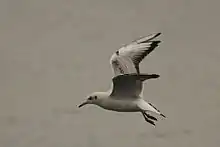
| Common name | Binomial | Status |
|---|---|---|
| Mediterranean gull | Ichthyaetus melanocephalus | Uncommon in winter and on passage |
| Laughing gull | Leucophaeus atricilla | Very rare, BBRC |
| Franklin's gull | Leucophaeus pipixcan | Very rare, BBRC |
| Little gull | Hydrocoloeus minutus | Uncommon on passage; rare to scarce in winter; |
| Sabine's gull | Xema sabini | Very rare, LROS |
| Black-headed gull | Chroicocephalus ridibundus | Abundant in winter, uncommon breeding |
| Ring-billed gull | Larus delawarensis | Very rare, LROS |
| Common gull | Larus canus | Abundant in winter, fairly common to common on passage |
| Lesser black-backed gull | Larus fuscus | Common in winter and on passage |
| Yellow-legged gull | Larus michahellis | Uncommon in winter and on passage |
| Herring gull | Larus argentatus | Common in winter, scarce to uncommon on passage |
| Caspian gull | Larus cachinnans | Uncommon in winter and on passage |
| Iceland gull | Larus glaucoides | Rare to scarce in winter, LROS |
| Glaucous gull | Larus hyperboreus | Rare to scarce in winter, LROS |
| Great black-backed gull | Larus marinus | Fairly common in winter, scarce to uncommon on passage |
| Black-legged kittiwake | Rissa tridactyla | Scarce on passage |
Terns
Order: Charadriiformes Family: Sternidae
Terns are slender seabirds with long, pointed wings, a pointed bill and a tail which is usually forked. There are about 44 species worldwide, 10 recorded in Leicestershire and Rutland.
| Common name | Binomial | Status |
|---|---|---|
| Caspian tern | Hydroprogne caspia | Very rare, BBRC |
| Sandwich tern | Sterna sandvicensis | Scarce on passage |
| Roseate tern | Sterna dougallii | Very rare, LROS |
| Common tern | Sterna hirundo | Uncommon to fairly common on passage, uncommon breeding |
| Arctic tern | Sterna paradisaea | Uncommon to fairly common on passage |
| Bridled tern | Onychoprion anaethetus | Very rare, BBRC |
| Little tern | Sternula albifrons | Scarce on passage |
| Whiskered tern | Chlidonias hybridus | Very rare, BBRC |
| Black tern | Chlidonias niger | Uncommon on passage |
| White-winged tern | Chlidonias leucopterus | Very rare, LROS |
Auks
Order: Charadriiformes Family: Alcidae
Auks are seabirds which are superficially similar to penguins with their black-and-white colours, their upright posture and some of their habits, but the living species are able to fly. There are about 23 species worldwide, four of which are rare vagrants in Leicestershire and Rutland.
| Common name | Binomial | Status |
|---|---|---|
| Common guillemot | Uria aalge | Very rare, LROS |
| Razorbill | Alca torda | Very rare, LROS |
| Little auk | Alle alle | Rare, LROS |
| Atlantic puffin | Fratercula arctica | Very rare, LROS |
Sandgrouse
Order: Pterocliformes Family: Pteroclidae
Sturdy, medium-sized birds with a small head and long, pointed wings. There are 16 species worldwide, one of which has occurred as a vagrant in Leicestershire and Rutland.
| Common name | Binomial | Status |
|---|---|---|
| Pallas's sandgrouse | Syrrhaptes paradoxus | Very rare, except at least 45 birds in an 1888 population peak and temporary range expansion, BBRC[12] |
Pigeons and doves
Order: Columbiformes Family: Columbidae
Pigeons and doves are stout-bodied birds with short necks and short slender bills with a fleshy cere. There are about 308 species worldwide, five of which occur in Leicestershire and Rutland.
| Common name | Binomial | Status |
|---|---|---|
| Feral pigeon | Columba livia | Common feral resident |
| Stock dove | Columba oenas | Common resident breeding |
| Common wood pigeon | Columba palumbus | Abundant resident breeding |
| Eurasian collared dove | Streptopelia decaocto | Common resident breeding |
| Turtle dove | Streptopelia turtur | Uncommon breeding summer visitor |
Cuckoos
Order: Cuculiformes Family: Cuculidae
Birds of variable size with slender bodies and long tails. Some species are lay their eggs in the nests of other birds. There are about 141 species worldwide, one of which breeds in Leicestershire and Rutland.
| Common name | Binomial | Status |
|---|---|---|
| Common cuckoo | Cuculus canorus | Fairly common breeding summer visitor |
Barn owls
Order: Strigiformes Family: Tytonidae
Barn owls are medium-sized to large owls with large heads and characteristic heart-shaped faces. They have long strong legs with powerful talons. There are about 16 species worldwide, with one in Leicestershire and Rutland.
| Common name | Binomial | Status |
|---|---|---|
| Barn owl | Tyto alba | Uncommon breeding resident |
Typical owls
Order: Strigiformes Family: Strigidae
Typical owls are small to large solitary nocturnal birds of prey. They have large forward-facing eyes and ears, a hawk-like beak and a conspicuous circle of feathers around each eye called a facial disc. There are about 199 species worldwide, with four recorded in Leicestershire and Rutland.
| Common name | Binomial | Status |
|---|---|---|
| Little owl | Athene noctua | Introduced. Fairly common resident breeding |
| Tawny owl | Strix aluco | Fairly common resident breeding |
| Long-eared owl | Asio otus | Scarce in winter, rare breeding |
| Short-eared owl | Asio flammeus | Uncommon in winter |
Nightjars
Order: Caprimulgiformes Family: Caprimulgidae
Nightjars are medium-sized nocturnal birds that usually nest on the ground. They have long wings, short legs and very short bills. Their soft plumage is cryptically coloured to resemble bark or leaves. There are about 91 species worldwide, one of which occurs in Leicestershire and Rutland.
| Common name | Binomial | Status |
|---|---|---|
| European nightjar | Caprimulgus europaeus | Rare to scarce in summer and on passage |
Swifts
Order: Apodiformes Family: Apodidae
The swifts are small birds which spend the majority of their lives flying. These birds have very short legs and never settle voluntarily on the ground, perching instead only on vertical surfaces. There are about 100 species worldwide, two of which have been recorded in Leicestershire and Rutland.
| Common name | Binomial | Status |
|---|---|---|
| Common swift | Apus apus | Common summer breeding visitor |
| Alpine swift | Apus melba | Very rare, LROS |
Kingfishers
Order: Coraciiformes Family: Alcedinidae
Kingfishers are medium-sized birds with large heads, long pointed bills, short legs and stubby tails. There are about 93 species worldwide, one of which breeds in Leicestershire and Rutland.
| Common name | Binomial | Status |
|---|---|---|
| Common kingfisher | Alcedo atthis | Uncommon breeding resident |
Bee-eaters
Order: Coraciiformes Family: Meropidae
A group of near-passerine birds characterised by richly coloured plumage, slender bodies and usually elongated central tail feathers. There are about 26 species worldwide, one of which has occurred in Leicestershire and Rutland.
| Common name | Binomial | Status |
|---|---|---|
| European bee-eater | Merops apiaster | Very rare, LROS |
Rollers
Order: Coraciiformes Family: Coraciidae
A small family of colourful, medium-sized birds with a crow-like shape that feed mainly on insects. There are about 12 species worldwide, one of which has occurred in Leicestershire and Rutland.
| Common name | Binomial | Status |
|---|---|---|
| European roller | Coracias garrulus | Very rare, BBRC |
Hoopoe
Order: Coraciiformes Family: Upupidae
A distinctive bird in its own family with a long curved bill, a crest and black-and-white striped wings and tail.
| Common name | Binomial | Status |
|---|---|---|
| Hoopoe | Upupa epops | Very rare, LROS |
Woodpeckers
Order: Piciformes Family: Picidae
Woodpeckers are small to medium-sized birds with chisel-like beaks, short legs, stiff tails and long tongues used for capturing insects. Many woodpeckers have the habit of tapping noisily on tree trunks with their beaks. There are about 219 species worldwide, four recorded in Leicestershire and Rutland.
| Common name | Binomial | Status |
|---|---|---|
| Eurasian wryneck | Jynx torquilla | Very rare, bred to 1903, LROS[5] |
| European green woodpecker | Picus viridis | Fairly common breeding resident |
| Great spotted woodpecker | Dendrocopos major | Fairly common breeding resident |
| Lesser spotted woodpecker | Dryobates minor | Uncommon breeding resident |
Larks
Order: Passeriformes Family: Alaudidae
Larks are small terrestrial birds with often extravagant songs and display flights. Most larks are fairly dull in appearance. Their food is insects and seeds. There are about 96 species worldwide, three of which have been recorded in Leicestershire and Rutland.
| Common name | Binomial | Status |
|---|---|---|
| Wood lark | Lullula arborea | Rare, bred to about 1840, LROS[5] |
| Skylark | Alauda arvensis | Common breeding, wintering and on passage |
| Shore lark | Eremophila alpestris | Very rare, LROS |
Swallows and martins
Order: Passeriformes Family: Hirundinidae
This is adapted to aerial feeding. They have a slender streamlined body, long pointed wings and a short bill with a wide gape. There are about 83 species worldwide, five of which have been recorded in Leicestershire and Rutland.
| Common name | Binomial | Status |
|---|---|---|
| Sand martin | Riparia riparia | Fairly common summer breeding visitor |
| Crag martin | Ptyonoprogne rupestris | Very rare, BBRC |
| Barn swallow | Hirundo rustica | Common summer breeding visitor |
| Red-rumped swallow | Hirundo daurica | Very rare, LROS |
| Common house martin | Delichon urbicum | Common summer breeding visitor |
Wagtails and pipits
Order: Passeriformes Family: Motacillidae
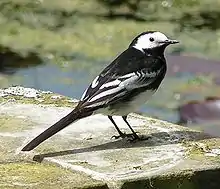
Motacillidae is a family of small passerine birds with medium to long tails. They are slender, ground-feeding insectivores of open country. There are about 66 species worldwide, 10 of which have been recorded in Leicestershire and Rutland.
| Common name | Binomial | Status |
|---|---|---|
| Citrine wagtail | Motacilla citreola | Very rare, BBRC |
| Pied wagtail | Motacilla alba | Common resident breeding |
| Grey wagtail | Motacilla cinerea | Uncommon resident breeding |
| Yellow wagtail | Motacilla flava | Uncommon summer breeding visitor, fairly common on passage |
| Richard's pipit | Anthus richardi | Very rare, LROS |
| Tree pipit | Anthus trivialis | Uncommon summer breeding visitor |
| Meadow pipit | Anthus pratensis | common on passage, fairly common in winter, uncommon breeding |
| Red-throated pipit | Anthus cervinus | Very rare, LROS |
| Water pipit | Anthus spinoletta | Very rare, LROS |
| Rock pipit | Anthus petrosus | Scarce in winter and on passage |
Waxwings
Order: Passeriformes Family: Bombycillidae
The waxwings are a group of passerine birds characterised by soft, silky plumage and unique red tips to some of the wing feathers. There are three species worldwide, one of which has been recorded in Leicestershire and Rutland.
| Common name | Binomial | Status |
|---|---|---|
| Bohemian waxwing | Bombycilla garrulus | Rare to scarce in winter |
Dippers
Order: Passeriformes Family: Cinclidae
Dark, dumpy, aquatic birds that are able to forage for food on the beds of rivers. There are five species worldwide, with one recorded in Leicestershire and Rutland.
| Common name | Binomial | Status |
|---|---|---|
| White-throated dipper | Cinclus cinclus | Very rare, bred to about 1840, LROS[5] |
Wrens
Order: Passeriformes Family: Troglodytidae

Wrens are small and inconspicuous birds, except for their loud songs. They have short wings and thin down-turned bills. There are about 80 species worldwide, with one breeding in Leicestershire and Rutland.
| Common name | Binomial | Status |
|---|---|---|
| Wren | Troglodytes troglodytes | Abundant resident breeding |
Accentors
Order: Passeriformes Family: Prunellidae
A small family of drab, unobtrusive, insectivorous birds with thin, pointed bills. There are 13 species worldwide, with one in Leicestershire and Rutland.
| Common name | Binomial | Status |
|---|---|---|
| Dunnock | Prunella modularis | Abundant resident breeding |
Thrushes
Order: Passeriformes Family: Turdidae
The thrushes are plump, soft-plumaged, small to medium-sized insectivores or sometimes omnivores, often feeding on the ground. Many have attractive songs. There are about 90 species worldwide, six in Leicestershire and Rutland.
| Common name | Binomial | Status |
|---|---|---|
| Common blackbird | Turdus merula | Abundant resident breeding |
| Ring ouzel | Turdus torquatus | Scarce to uncommon on passage, formerly bred in the 19th century, LROS[5] |
| Fieldfare | Turdus pilaris | Common in winter, rare in summer |
| Redwing | Turdus iliacus | Common in winter |
| Song thrush | Turdus philomelos | Common resident breeding |
| Mistle thrush | Turdus viscivorus | Common resident breeding |
Cettid warblers
Order: Passeriformes Family: Cettiidae
| Common name | Binomial | Status |
|---|---|---|
| Cetti's warbler | Cettia cetti | Rare in winter and on passage |
Locustellid warblers
Order: Passeriformes Family: Locustellidae
| Common name | Binomial | Status |
|---|---|---|
| Common grasshopper warbler | Locustella naevia | Uncommon breeding summer visitor |
| Savi's warbler | Locustella luscinioides | Very rare, LROS |
Acrocephalid warblers
Order: Passeriformes Family: Acrocephalidae
| Common name | Binomial | Status |
|---|---|---|
| Aquatic warbler | Acrocephalus paludicola | Very rare, one occurrence in 1864, LROS[13] |
| Sedge warbler | Acrocephalus schoenobaenus | Common breeding summer visitor |
| Eurasian reed warbler | Acrocephalus scirpaceus | Fairly common breeding summer visitor |
| Marsh warbler | Acrocephalus palustris | Very rare, LROS |
| Great reed warbler | Acrocephalus arundinaceus | Very rare, BBRC |
Phylloscopid warblers
Order: Passeriformes Family: Phylloscopidae
| Common name | Binomial | Status |
|---|---|---|
| Willow warbler | Phylloscopus trochilus | Abundant breeding summer visitor |
| Common chiffchaff | Phylloscopus collybita | Common breeding summer visitor, scarce to uncommon in winter |
| Western Bonelli's warbler | Phylloscopus bonelli | Very rare, BBRC |
| Wood warbler | Phylloscopus sibilatrix | Scarce on passage, rare breeding |
| Yellow-browed warbler | Phylloscopus inornatus | Very rare, LROS |
| Greenish warbler | Phylloscopus trochiloides | Very rare, LROS |
Old World warblers
Order: Passeriformes Family: Sylviidae A group of small, insectivorous passerine birds. Most are of generally undistinguished appearance, but many have distinctive songs.
| Common name | Binomial | Status |
|---|---|---|
| Eurasian blackcap | Sylvia atricapilla | Common breeding summer visitor, uncommon in winter |
| Barred warbler | Sylvia nisoria | Very rare vagrant. One record in 2018 LROS |
| Garden warbler | Sylvia borin | Fairly common breeding summer visitor |
| Whitethroat | Sylvia communis | Common breeding summer visitor |
| Lesser whitethroat | Sylvia curruca | Fairly common breeding summer visitor |
Kinglets
Order: Passeriformes Family: Regulidae
A family of very small birds. There are seven species worldwide, with two in Leicestershire and Rutland.
| Common name | Binomial | Status |
|---|---|---|
| Goldcrest | Regulus regulus | Fairly common to common breeding summer visitor |
| Common firecrest | Regulus ignicapillus | Rare in winter and on passage |
Old World flycatchers
Order: Passeriformes Family: Muscicapidae
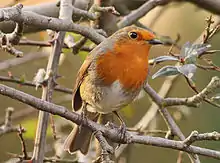
The flycatchers are small birds that fly out from a perch to catch insects in the air or from the ground. There are about 120 species worldwide, 11 of which have been recorded in Leicestershire and Rutland.
| Common name | Binomial | Status |
|---|---|---|
| Spotted flycatcher | Muscicapa striata | Uncommon breeding summer visitor |
| European pied flycatcher | Ficedula hypoleuca | Rare to scarce on passage, very rare breeding |
| Bluethroat | Luscinia svecica | Very rare, LROS |
| Nightingale | Luscinia megarhynchos | Uncommon breeding summer visitor |
| Red-flanked bluetail | Tarsiger cyanurus | Very rare, BBRC |
| European robin | Erithacus rubecula | Abundant resident breeding |
| European stonechat | Saxicola rubicola | Uncommon in winter and on passage |
| Whinchat | Saxicola rubetra | Uncommon on passage, rare breeding |
| Northern wheatear | Oenanthe oenanthe | Uncommon on passage, very rare breeding |
| Black redstart | Phoenicurus ochruros | Scarce in winter and on passage, rare breeding |
| Common redstart | Phoenicurus phoenicurus | Uncommon in summer and on passage, rare breeding |
Bearded reedling
Order: Passeriformes Family: Panuridae
| Common name | Binomial | Status |
|---|---|---|
| Bearded reedling | Panurus biarmicus | Rare in winter and on passage |
Long-tailed tits
Order: Passeriformes Family: Aegithalidae
Small, long-tailed birds that typically live in flocks for much of the year. There are eight species worldwide, with one breeding in Leicestershire and Rutland.
| Common name | Binomial | Status |
|---|---|---|
| Long-tailed tit | Aegithalos longicaudus | Common breeding resident |
Tits
Order: Passeriformes Family: Paridae
Tits are mainly small, stocky, woodland species with short stout bills. They are adaptable birds, with a mixed diet including seeds and insects. There are about 59 species worldwide, five breeding in Leicestershire and Rutland.
| Common name | Binomial | Status |
|---|---|---|
| Marsh tit | Parus palustris | Fairly common resident breeding |
| Willow tit | Parus montana | Common but declining resident breeding |
| Coal tit | Parus ater | Common resident breeding |
| Great tit | Parus major | Abundant resident breeding |
| Blue tit | Parus caeruleus | Abundant resident breeding |
Nuthatches
Order: Passeriformes Family: Sittidae
Nuthatches are small woodland birds with the unusual ability to climb down trees head-first, unlike other birds which can only go upwards. There are about 24 species worldwide, one breeding in Leicestershire and Rutland.
| Common name | Binomial | Status |
|---|---|---|
| Eurasian nuthatch | Sitta europaea | Fairly common resident breeding |
Treecreepers
Order: Passeriformes Family: Certhiidae
Treecreepers are small woodland birds, brown above and white below. They have thin, pointed, down-curved bills, which they use to extricate insects from bark. There are seven species worldwide, one breeding in Leicestershire and Rutland.
| Common name | Binomial | Status |
|---|---|---|
| Common treecreeper | Certhia familiaris | Common resident breeding |
Old World orioles
Order: Passeriformes Family: Oriolidae
The orioles are medium-sized passerines, mostly with bright and showy plumage, the females often duller plumage than the males The beak is long, slightly curved and hooked. Orioles are arboreal and tend to feed in the canopy. There are 27 species worldwide, one of which has been recorded in Leicestershire and Rutland.
| Common name | Binomial | Status |
|---|---|---|
| Eurasian golden oriole | Oriolus oriolus | Rare in summer and on passage, LROS |
Shrikes
Order: Passeriformes Family: Laniidae
Shrikes are passerine birds with a habit of catching other birds and small animals and impaling the uneaten portions of their bodies on thorns. A typical shrike's beak is hooked, like that of a bird of prey. There are about 30 species worldwide, three of which have been recorded in Leicestershire and Rutland.
| Common name | Binomial | Status |
|---|---|---|
| Great grey shrike | Lanius excubitor | Rare, LROS |
| Red-backed shrike | Lanius collurio | Very rare, bred to 1944, LROS[5] |
| Woodchat shrike | Lanius senator | Very rare, LROS |
Crows and allies
Order: Passeriformes Family: Corvidae
The crows and their relatives are fairly large birds with strong bills and are usually intelligent and adaptable. There are about 119 species worldwide, eight of which have been recorded in Leicestershire and Rutland.
| Common name | Binomial | Status |
|---|---|---|
| Carrion crow | Corvus corone | Common resident breeding |
| Common raven | Corvus corax | Scarce in winter and on passage, rare resident breeding |
| Hooded crow | Corvus cornix | Very rare, LROS |
| Eurasian jackdaw | Corvus monedula | Common resident breeding |
| Rook | Corvus frugilegus | Abundant resident breeding |
| Eurasian jay | Garrulus glandarius | Fairly common resident breeding |
| European magpie | Pica pica | Common resident breeding |
| Spotted nutcracker | Nucifraga caryocatactes | Very rare, BBRC |
Starlings
Order: Passeriformes Family: Sturnidae
Starlings are small to medium-sized passerine birds with strong feet. Their flight is strong and direct and most are very gregarious. There are about 114 species worldwide, two of which have been recorded in Leicestershire and Rutland.
| Common name | Binomial | Status |
|---|---|---|
| Rosy starling | Pastor roseus | Very rare, LROS |
| Common starling | Sturnus vulgaris | Abundant breeding, in winter and on passage |
Sparrows
Order: Passeriformes Family: Passeridae
Sparrows tend to be small, plump, brownish or greyish birds with short tails and short, powerful beaks. They are seed-eaters and they also consume small insects. There are about 38 species worldwide, two of which have been recorded in Leicestershire and Rutland.
| Common name | Binomial | Status |
|---|---|---|
| House sparrow | Passer domesticus | Common resident breeding |
| Eurasian tree sparrow | Passer montanus | Fairly common resident breeding |
Finches
Order: Passeriformes Family: Fringillidae
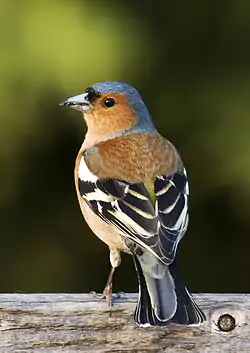
Seed-eating passerine birds that are small to moderately large and have a strong beak, usually conical and in some species very large. There are about 176 species worldwide, 13 of which have been recorded in Leicestershire and Rutland.
| Common name | Binomial | Status |
|---|---|---|
| Common chaffinch | Fringilla coelebs | Abundant resident breeding |
| Brambling | Fringilla montifringilla | Uncommon to fairly common in winter and on passage |
| Common crossbill | Loxia curvirostra | Rare to scarce in winter, very rare breeding, LROS |
| European greenfinch | Chloris chloris | Common to abundant resident breeding |
| Common redpoll | Acanthis flammea | Rare in winter and on passage, LROS |
| Lesser redpoll | Acanthis cabaret | Fairly common in winter and on passage, rare breeding |
| Arctic redpoll | Acanthis hornemanni | Very rare, LROS |
| Eurasian siskin | Spinus spinus | Fairly common to commonin winter, very rarebreeding |
| European goldfinch | Carduelis carduelis | Common resident breeding |
| Twite | Linaria flavirostris | Rare in winter and on passage, LROS |
| Common linnet | Linaria cannabina | Fairly common in winter, common breeding |
| Eurasian bullfinch | Pyrrhula pyrrhula | Common resident breeding |
| Hawfinch | Coccothraustes coccothraustes | Scarce on passage, rare breeding |
Longspurs and arctic buntings
Order: Passeriformes Family: Calcariidae
| Common name | Binomial | Status |
|---|---|---|
| Snow bunting | Plectrophenax nivalis | Rare in winter and on passage, LROS |
| Lapland bunting | Calcarius lapponicus | Very rare in winter and on passage, LROS |
Buntings
Order: Passeriformes Family: Emberizidae

The Emberizidae are a large family of seed-eating passerine birds with distinctively shaped bills. There are about 372 species worldwide, eight of which have been recorded in Leicestershire and Rutland.
| Common name | Binomial | Status |
|---|---|---|
| Yellowhammer | Emberiza citrinella | Common resident breeding |
| Cirl bunting | Emberiza cirlus | Very rare, bred to 1920, LROS[5] |
| Black-headed bunting | Emberiza melanocephala | Very rare, BBRC |
| Reed bunting | Emberiza schoeniclus | Common resident breeding |
| Corn bunting | Miliaria calandra | Uncommon resident breeding |
Footnotes
- "Leicestershire and Rutland Ornithological Society". LROS. Retrieved 3 April 2010
- Downloadable Excel file from "Checklist of Leicestershire & Rutland Birds". LROS. Retrieved 29 May 2010
- Fray (2009) p. 14
- Dudley, Steve P; Gee, Mike; Kehoe, Chris; Melling, Tim M.; The British Ornithologists’ Union Records Committee (BOURC) (2006). "The British List: A Checklist of Birds of Britain (7th edition)". Ibis. 148 (3): 526–563. doi:10.1111/j.1474-919X.2006.00603.x.
- Fray (2009) p. 32
- Fray (2009) pp. 234–238
- Fray (2009) pp. 215–218
- Fray (2009) p. 234
- Fray (2009) p. 255
- Fray (2009) p. 272
- Fray (2009) p. 312
- Fray (2009) p. 406
- Fray (2009) p. 534
Cited text
- Fray, Rob; Davies, Roger; Gamble, Dave; Harrop, Andrew; Lister, Steve (2009). The Birds of Leicestershire and Rutland. Christopher Helm. ISBN 978-0-7136-7233-6.
External links
| Wikimedia Commons has media related to |

